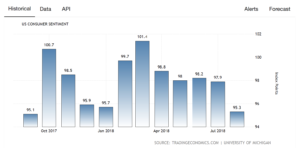For many, August symbolizes beginnings. The hottest month brings a new school year and the long-awaited season of fall. One might think that these changes would encourage people to go shopping and buy new things, but this year, that is not the case. Consumer confidence hit an 11-month low in the United States. But what does that mean, exactly?
Consumer confidence is based on several factors. Each month, the American Conference Board surveys 5000 households to measure how optimistic or pessimistic consumers feel about the economy’s current and future performance. This is a leading economic indicator because if citizens believe that the economy is going to do well, they will want to purchase more, regardless of whether it’s smart to do so or not.
Earlier this month, the University of Michigan released that total sentiment fell to an 11-month low. The study revealed that the consumer confidence index (CCI) score fell from 97.9 in July to 95.3 in August, Reuters reports. This is how they got this number:
The CCI survey features a series of questions asking if the individual feels positive, negative, or neutral about the current and future economy. 40% of the questions concern the current economy, while 60% concern the future. Then, the Conference Board puts the responses into numbers by taking the amount of positive responses divided by the positive and negative responses combined. The scores are then averaged, and then compared to a benchmark value of 100.
This sounds complicated, but essentially it’s just an algorithm that quantifies consumer confidence.
The CCI is key because manufacturers use it to determine how much of their products they should produce. For example, if Apple sees that consumers are extremely confident this month, they might hire more factory workers to anticipate a boom in MacBook sales. This is a smart way for business to stay ahead of the supply and demand curve.
Economists, however, consider the CCI a lagging indicator, meaning it fluctuates after the economy changes, not before. In reality, though, if people think the economy is doing great and spend a lot of money, then in turn it will do great. Americans have the power to boost their economic futures by simply staying positive, but they tend to be pessimists. Current events seriously affect their outlook.
For example, the decline in CCI this month stemmed from the bottom third of the economy believing that this is a terrible time to buy large goods. This roots from an increased inflation rate over the past few months. Politics also play into sentiments, as the Trump administration’s protectionist trade policy has led Americans to believe that import duties will continue to rise.
Though consumer confidence is falling, one thing is for certain– it will rise again. The economy rises and falls every single day. Congress is constantly pushing new economic legislation. Changing weather conditions determine the price of goods. Trends lead people to buy certain things and not others. While it is scary to not know what the future holds, it can also be comforting.
SOURCES:
https://www.youtube.com/watch?v=YtT0cO9038E
https://tradingeconomics.com/united-states/consumer-confidence

